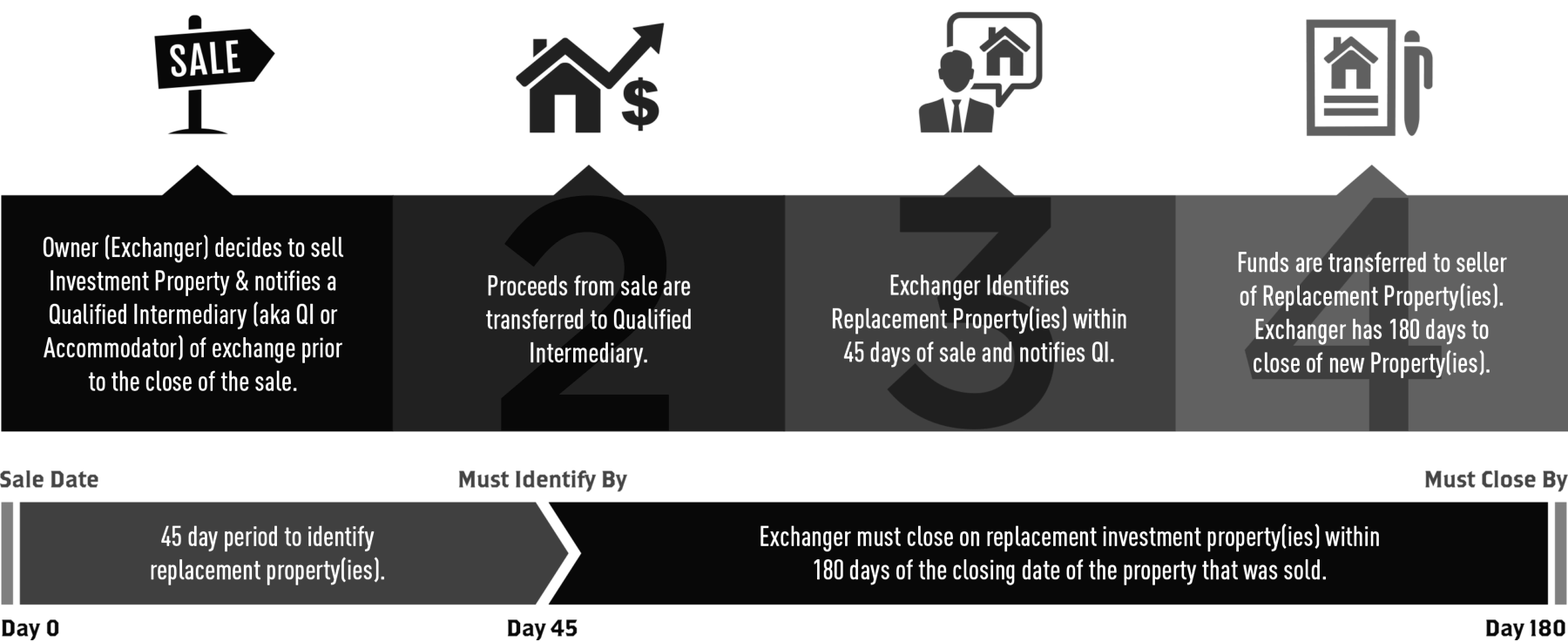Capital Gains Taxes
In a 1031 Exchange, the seller does't actually pay taxes on the disposition of the property. Instead, the capital gains taxes on the relinquished property are deferred to a later date than they would normally be paid. A capital gain results when the selling price of an asset is higher than its original purchase price. Capital gains are subject to a minimum of 15% tax for individuals and 21% tax for corporations.
Advantages of a 1031 Exchange
The primary advantage of a tax-deferred exchange is that the taxpayer may dispose of property without incurring any immediate tax liability. This allows a taxpayer to keep the earning power of deferred tax dollars while at the same time exchanging assets.
Rather than selling real estate, paying the capital gains tax, and then using the net proceeds to buy another property, the 1031 Exchange rules allow an investor to forego paying the capital gains tax and use the total proceeds of the sale to invest in the new property, thereby deferring the capital gains tax until the new property is sold.
Investment Property Example
For example, John, who personally owns an investment property in New York City worth $10 million, wants to sell his property and buy a different one. Without the ability to use a 1031 tax deferred exchange, John would have to pay the government approximately $2.34 million in capital gains taxes, reducing the amount that he can reinvest in the replacement property to only $7.66 million. For simplicity, I have left out the treatment of closing costs on entry and exit of the investment. These costs can be deducted from the capital gain to get the true capital gains tax.
However, following Revenue procedure 2000-37 of the IRC, John acquires the replacement property and transfers the tax basis of the old property to the new property. He would be able to forego the $2.34 million tax and defer it until he sells the replacement property, usually many years later. Reinvesting pre-tax dollars in another a replacement property acquired using a 1031 tax exchange has great value and most sophisticated property investors know this is one of the quickest ways to grow wealth.
Sheltered Gains Due When Replacement Property is Sold
The sheltered gain will be ultimately due upon the sale of the replacement property, although that is not always the case if the property is inherited, as investor’s heirs get a stepped-up cost basis on such inherited property. Upon the investor’s death, his or her heirs would receive the property at fair market value at the date of transfer to the heirs; not the basis transferred to the replacement property from the original purchase.
When the heir goes to sell the property, they will pay tax on the difference between the new selling price and the fair market value of the property at the time of inheritance.
In addition, another advantage of using a 1031 exchange is that, ultimately, the investment property can be converted to a primary residence, as long as this is done after 2 years of ownership under the safe harbor rules.
Note that for a 1031 to be effective, title to the replacement property must be held using the same tax identification number of the property that was sold.
Like-Kind Property
1031 Exchange rules require that the two properties be “like-kind” property. The rules consider the exchange of residential investment property for residential investment property, commercial investment property for commercial investment property, residential investment property for commercial investment property and vice versa, to be like-kind.
The property, however, must be in the US, as an exchange of US property for foreign property is not considered “like-kind” under the rules.
Disadvantages of a 1031 Exchange
The taxpayer should also consider that there are a couple of disadvantages to a tax-deferred exchange, as follows:
-
There will be a reduced basis (i.e., tax value) in the replacement property, since the lower basis from the old property will transfer to the new property. Because of this, the taxpayer will have lower depreciation deductions on the new property than he or she would have had if he or she purchased the property without a 1031 exchange.
-
There will be increased transactional costs for completing a tax-deferred exchange, as the owner will incur additional professional fees and closing costs.
-
The taxpayer may not use any of the net proceeds from the disposition of the property for anything except reinvestment in real property. Otherwise, there will be tax consequences on the amount of the proceeds not used as reinvestment.
Eligible Properties for a 1031 Exchange
A 1031 exchange allows savvy real estate investors to exchange one investment property for another, deferring federal capital gains taxes in the process. To qualify for a 1031 exchange, the properties involved must be “like-kind,” meaning they are of the same nature or character. This can include a wide range of property types, such as:
-
Apartment buildings
-
Duplexes
-
Single-family rental properties
-
Commercial office building rentals
-
Vacation home rentals
-
Restaurant property rentals
The Internal Revenue Service (IRS) considers real estate property to be like-kind regardless of how the real estate is improved. For example, an investor can exchange a small apartment building for a larger apartment project, an office building, or vacant land. This flexibility allows real estate investors to diversify their portfolios while deferring capital gains taxes, making the 1031 exchange a powerful tool for growing wealth in the real estate market.
1031 exchange only relates to real estate and not other business property.
1031 Exchange Requirements
To qualify for a 1031 exchange, real estate investors must meet specific requirements and follow certain rules. The exchange process must follow the below rules:
-
The property must be held for investment or used in a trade or business.
-
The property must be exchanged for a like-kind property.
-
The exchange must be completed within 180 days.
-
Identify potential replacement properties within 45 days of the sale. Investors are allowed to identify up to three properties. Of these three potential replacement properties, at least one of which must be used in the transaction.
-
The exchange must be completed through a qualified intermediary.
Additionally, the replacement property must be of equal or greater value to the sold property to defer capital gains taxes on the entire amount of the proceeds from the sale of the original property. Meeting these requirements is crucial for real estate investors looking to leverage the benefits of a 1031 exchange and defer capital gains taxes effectively.
You can purchase multiple properties as long as their combined value is equal to or greater than the property being sold.
Qualified Intermediary
A 1031 Exchange requires a Qualified Intermediary, as defined by Section 1031 of the Internal Revenue Code, to handle the entire process.
All of the proceeds from the sale, including non-cash proceeds (such as a car that you might receive in trade in addition to the property), must go to the Qualified Intermediary to be used for the purchase of the new property. Anything received directly or indirectly by the seller (no matter how insignificant) will disqualify the entire transaction, resulting in the recognition of the entire gain (and in the case of a Foreign Buyer, resulting in FIRPTA withholding).
1031 Exchange Timeline:
Very specific rules regarding the identification and exchange periods
-
The new property must be located within the US.
-
From the closing date of the old property, the seller has 45 days to provide the Qualified Intermediary with a list of properties they want to buy (this list is called “The 45-Day List” and there is typically more than one property on the list in case a deal falls through).
-
From the closing date of the old property, the seller has 180 calendar days to purchase one or more of the properties on The 45-Day List;
-
The seller of the old property must take title to the new property in the same legal name in which they owned the old property.
-
The seller must buy new property for an amount equal to, or greater than, the sale price of the old property.
-
Cash from the sale of the old property, after paying closing costs and liabilities, must go to the Qualified Intermediary and be used for the purchase of the new property.
The 45-day timeline must be strictly followed, as it is not extendable in any way, even if the 45th day falls on a Saturday, Sunday or legal US holiday.
The Exchange Period ends at exactly 180 days after the date on which the person transfers the relinquished property or on the due date for the person’s tax return for that taxable year in which the transfer of the relinquished property has occurred, whichever is earlier. Again, the 180-day timeline must be strictly followed, as it is not extendable in any way, even if the 180th day falls on a Saturday, Sunday or legal US holiday.

Reverse 1031 Exchange
Reverse exchanges are a tool that investors can use to defer capital gains tax even when the replacement property must close before the relinquished property closes.
The investor, however, can't take possession of the replacement property in a reverse 1031 exchange until the whole transaction is done. Generally, the replacement property must be held by an Exchange Accommodation Titleholder (similar in concept to the qualified intermediary requirement in a 1031 exchange) until the relinquished property is sold.
Disadvantages of Reverse 1031 Exchange
- There are even more strict rules around this process than a normal 1031 Exchange, which has lots of rules, so you will need professional help to implement it.
- Potential issues with financing, as one may need to have the capacity to purchase the replacement property first before receiving any funds from the sale of the relinquished property.
Reverse 1031 Exchange Timeline
The timelines for a 1031 reverse exchange are the same as those for other types of 1031 exchanges: 45 days: Relinquished property must be identified within 45 days of the closing of the replacement property's purchase, with closing taking place within 180 days.
Advantages of Reverse 1031 Exchange
-
A Reverse 1031 Exchange allows an investor to defer the capital gain tax on the relinquished property, even though the investor first purchases the replacement property.
-
A reverse 1031 exchange can ease the pressure associated with a 1031 transaction because the investor already has the replacement property lined up beforehand.
-
Allows an investor to lock in a replacement property at a time and price of the investor’s choosing.
-
An investor has more control over the closing price when listing relinquished property.
Disadvantages of Reverse 1031 Exchange
-
There are even more strict rules around this process than a normal 1031 Exchange, which has lots of rules, so you will need professional help to implement it.
-
Potential issues with financing, as one may need to have the capacity to purchase the replacement property first before receiving any exchange funds from the initial sale of the relinquished property.
Tax Implications of a 1031 Exchange
A 1031 exchange is a tax-deferral strategy, not a tax-elimination one. Eventually, if you sell an investment property and choose not to reinvest the proceeds through a 1031 exchange, the capital gains tax comes due. However, by using a 1031 exchange, a real estate investor can defer paying capital gains taxes when the proceeds from real estate sold are used to buy replacement real estate.
The tax implications of a 1031 exchange can be significant. For example, if an investor sells a property for $2 million and uses the proceeds to purchase a replacement property worth $2.5 million, they can defer paying capital gains taxes on the $500,000 profit. This can result in significant tax savings, especially for a savvy businessperson who appreciates the benefits of real estate investing. Growing a portfolio pre-tax has obvious benefits.
It’s worth noting that the Tax Cuts and Jobs Act of 2017 eliminated personal and intangible property from being included in tax-deferred exchanges. However, opportunity zones are still available in all 50 states and U.S. Territories, and are designed to encourage long-term and tax-deferred investments in urban and rural areas with low incomes.
In conclusion, a 1031 exchange is a powerful tool for real estate investors looking to defer capital gains taxes and grow their portfolios. By understanding the eligible properties, requirements, and tax implications of a 1031 exchange, investors can make informed decisions and maximize their tax savings.
1031 Exchange Considerations for Foreign Investors
Non US sellers can also qualify for 1031 treatment of their assets
The US government makes it possible for a Foreign Seller to use the 1031 Exchange provisions. In addition to the normal rules noted above, FIRPTA imposes an additional requirement upon 1031 Exchange rules in order to avoid the 15% withholding. The additional requirement is that the individual responsible for transferring the old property from the Foreign Seller to the buyer/transferee (such as a title or escrow company) must receive from the Foreign Seller either:
-
A Withholding Certificate issued by the IRS that sanctions the particular exchange and allows the transferee to avoid withholding any tax, or;
-
Notice from the Foreign Seller that certifies that the seller has applied for a Withholding Certificate.
First, any foreign property owner should plan ahead to obtain an ITIN far in advance of transferring any real estate, and to apply for a withholding certificate as soon as any property transfer has been arranged.
Second, it is critical that any Foreign Seller wishing to complete a 1031 Exchange consults with a knowledgeable, professional, qualified intermediary early in the sale process, and as well procures tax or financial counsel from experienced advisors, to assist them with the closing and US tax filing process. If you would like references for a Qualified Intermediary, please let us know.
Additional resource from our CPA re: Foreign nationals using 1031 exchanges:
The property is owned by a foreign individual for tax purposes, which would make this exchange fall under FIRPTA. Under FIRPTA, if a property is purchased from a non-resident alien, the US buyer must withhold 15% of the value of the property in the transaction to send to the IRS. However, if certain conditions are met, no withholding is required.
If the transferor provides a written notice to the transferee stating that the transfer is not subject to recognition of gain or loss under a nonrecognition provision of the IRC, and the transferee provides the written notice to the IRS within 20 days of the transfer, the transferee is not required to withhold.
In addition to the steps listed above, Section 1445-2(d)(2)(iv) states that the above withholding exclusion is only available to participants of a section 1031 transaction, if the transaction is done simultaneously, i.e., both transfers under the section 1031 exchange take effect on the same day.
The FIRPTA withholding requirement is triggered if a foreign individual receives cash (or other property) as part of a transaction, and the value of the property surrendered by the foreign individual is greater than the value of the property received. This could happen, for example, if the property surrendered has no mortgage but the property received has a mortgage which is assumed.
In the event of meeting the special section 1031 limitations, i.e. the simultaneous requirement and the no-boot rule, the only way to prevent FIRPTA withholding is to obtain a withholding certificate from the IRS.
To summarize, the following steps are necessary, assuming the requirements of section 1031 are otherwise complied with:
-
Ensure that there is absolutely no boot, i.e., no cash is being transferred in the exchange to the foreign individual.
-
Ensure that the exchange contract and closing documents specifically result in both transfers being effective on the same day.
-
Ensure that a written notice of non-recognition is provided by the foreign individual the other party to the exchange containing the requirements for the notice listed above.
-
Ensure that other party to the exchange receiving the notice sends the notice to the IRS, at the following address: P.O. Box 21086, Drop Point 8731, FIRPTA Unit, Philadelphia, PA 19114-0586
Note: Legal counsel should be consulted and provide legal advice to make sure these matters are accomplished at closing.
1031 Exchange Florida and New York
While the Federal Tax rules still apply, allowing the deferral of capital gains as noted above, for a 1031 Exchange New York rules require those who are not New York residents to pay 7.7% state income tax on any gain realized from the sale. However, for a 1031 exchange nyc rules
For a 1031 Exchange Florida has no state income tax, so there is no state income tax on any gain realized from the sale.
Vacation Rental Property Hold Time in Florida
In order to prevent the IRS from challenging whether a vacation rental property qualifies for a 1031 exchange, it must be rented out for at least 14 nights each year for a two-year period.
Your personal use of a vacation rental property must not exceed 14 nights per year or 10% of the number of days in a one-year period that the property is rented out. The time that you spend at the property to carry out repairs, annual maintenance, and so forth are not counted towards the 14-day limit.
Manhattan Miami Real Estate LLC can help you with your 1031 Exchange
Looking for 1031 Exchange companies in Florida or NY? Below is how we can help you as a property investor.
We can:
Help you upgrade or downgrade using a Florida 1031 Exchange or New York 1031 exchange;
List and sell your NYC or Miami property on an exclusive basis;
Source individual investment properties, bulk purchase opportunities of condominiums and multi family properties;
Facilitate your tenants relocation;
Find and screen qualified tenants;
Manage the turnover of the property;
Provide property management services while the property is being rented (some of which we do at no cost to the owner);
Guide owners through the entire 1031 process along with our team of attorneys and qualified intermediaries who have many years of experience with 1031 exchanges.
We have lots of experience with 1031 transactions and can provide assistance at any point within an investment property lifecycle.
What's the next step?
Schedule a time to talk with our Managing Broker Anthony Guerriero, MBA, CPA so we can better understand your needs. And in the meantime, below you can browse residential condo properties in both Manhattan and Miami.



-2.png?width=500&height=205&name=MIAMI%20HOME%20SEARCH%20(2)-2.png)














